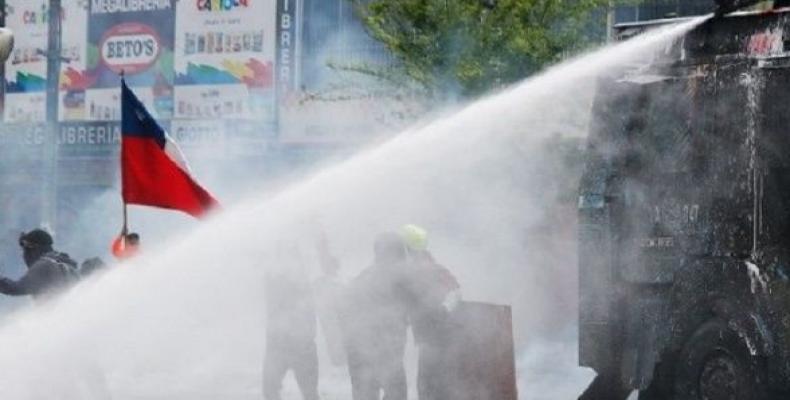Santiago de Chile, December 18 (RHC)-- Chile's Association of Doctors, Pharmaceutical Chemists, and the 'Health Resistance Movement' (Movimiento Salud en Resistencia) reported Monday that traces of caustic soda and pepper spray compounds has been found in a sample of water launched by riot police against demonstrators.
The report says that the compound is "highly corrosive to direct contact" and is "outside any legal norm regarding the use of riot control elements.
The investigation took place after a group of demonstrators delivered a sample of the water used to repel the protests in Chile, which was refrigerated for further processing. Caustic soda is a caustic hydroxide mainly used in the manufacture of pulp and paper, alumina, soap and detergents.
"The analysis report shows that the water contains highly irritating elements, with pH equal to 12 on a scale of one to 14, potentially deadly and capable of causing severe damage in the face of dermal contact, eye contact or accidental ingestion," it reads.
Chile's Police have denied the presence of caustic soda in the water thrown by the water cannons, saying that the use of this substance is not within the protocols of that security force. "It is not in the protocol of action, the control of public order, nor the control of crowds. It is not even in the manual on the use of force. There is no way to be able to use this product in public order control," said its Logistics Director Jean Camus.
According to a report released on November 26th by Human Rights Watch, Chilean security forces committed “serious human rights violations” during the now two-month-long protests against the neoliberal policies of President Sebastian Piñera and the lack of social rights in the South American nation.
The evidence collected is "consistent" to assert that the police "used force excessively in response to the protests and wounded thousands of people, regardless of whether they had participated in violent acts or not," according to the report.
The National Institute of Human Rights of Chile (NHRI) reported that 2,808 people have been wounded during the nearly 40 days of demonstrations. According to the Chilean agency, 232 people suffered eye injuries (75 percent of the cases of gunshots).
The Inter-American Commission on Human Rights (IACHR) along with numerous other rights groups condemned the constant violations of human rights by police and military against the population in Chile.
Massive demonstrations against the Chilean government began in Santiago on Oct. 14 due to a 30-cent increase in the subway fare.
While this measure was revoked by Piñera, social unrest increased in magnitude as the Chileans began to question "30 years" of neoliberal policies, which have implied a systematic withdrawal of economic and social rights for millions of people.


